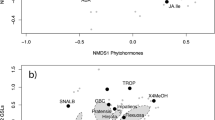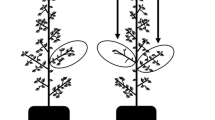Abstract
We tested the hypothesis that plant loss to insects, and thus the relative fitness of an annual, was inversely related to spatial variation in the concentration of its characteristic secondary compound, methylglucosinolate, a mustard oil precursor. We found that methylyglucosinolate concentrations decreased significantly and linearly from the dry to the wet end along short soil moisture gradients in dry shortgrass prairie. Both leaf damage and capsule predation increased from the dry to the wet end. Thus, the glucosinolate appears to function defensively. Plant growth and flower production were favored at the wet end of the gradient; yet plants in the wet portion of the gradient were also more vulnerable to significant insect damage. The net result was that seed production by individual plants after predation was actually greater in the drier, harsher half of the gradient. The outcome strongly suggests that environmentally related variation in secondary compound concentration along environmental gradients can mediate and influence host-plant population abundance and distribution.
Similar content being viewed by others
References
Blua, M.J. 1984. Glucosinolate variation inIsomeris (Cappariaceae). M.S. thesis, San Diego State University, San Diego, CA. 75 pp.
Blua, M.J., andHanscom, Z., III. 1986. Isolation and characterization of glucocapparin inIsomeris arborea Nutt.J. Chem. Ecol. 12:1449–1458.
Bryant, J.P., Chapin, F.S., III, andKlein, D.R. 1983. Carbon nutrient balance of boreal plants in relation to vertebrate herbivory.Oikos 40:357–368.
Cantlon, J.E. 1969. The stability of natural populations and their sensitivity to technology.Brookhaven Symp. Biol. 22:197–205.
Cates, R.G., andAlexander, H.J. 1982. Host resistance and susceptibility, Chapter 7,in J.B. Mitton and K. Sturgeon (eds.). Bark Beetles of North America and Conifers: Ecology and Evolution. University of Texas Press, Austin.
Cates, R.G., Redak, R.A., andHenderson, C.B. 1983. Patterns in defensive natural product chemistry: Douglas fir and western spruce budworm interactions, pp. 3–19,in P.A. Hedin (ed.). Plant Resistance to Insects. American Chemical Society, Washington, D.C.
Coley, P.D., Bryant, J.P., andChapin, F.S., III. 1985. Resource availability and plant antiherbivore defense.Science 230:895–899.
Dolinger, P.M., Ehrlich, P.R., Fitch, W.L., andBreedlove, D.E. 1973. Alkaloid and predation patterns in Colorado lupine populations.Oecologia (Berlin) 13:191–204.
Ehrlich, P.R., andRaven, P.H. 1965. Butterflies and plants: A study in coevolution.Evolution 18:586–608.
Farris, M.A. 1985. Demographic variation and natural selection in an annual plant growing along soil moisture gradients. PhD thesis, University of Colorado, Boulder, Colorado.
Feeny, P. 1975. Biochemical coevolution between plants and their insect herbivores, pp. 3–19,in L. Gilbert and P.H. Raven (eds.). Coevolution of Animals and Plants. University of Texas, Austin.
Feeny, P. 1976. Plant apparency and chemical defense.Recent Adv. Phytochem. 10:1–40.
Feeny, P., andRosenberry, L. 1982. Seasonal variation in the glucosinolate content of North AmericanBrassica nigra andDentaria species.Biochem. Syst. Ecol. 10:23–32.
Fraenkel, G. 1959. The raison d'etre of secondary plant substances.Science 129:1466–1470.
Goury, G. andGuignon, J. 1908. Insects parasites des capparidees.Feuille des jeunes naturalistes (Paris) 38:118–119.
Handel, S.N. 1976. Population ecology of three woodlandCarex species. Ph.D. thesis, Cornell University, Ithaca, New York.
Harper, J.L.1977. Population Biology of Plants. Academic Press, New York.
Huffaker, C.B., andKennett, C.E. 1959. A ten-year study of vegetational changes associated with biological control of klamath weed.J. Range Manag. 12:69–82.
Janzen, D.H. 1971. Seed predation by animals.Annu. Rev. Ecol. Syst. 2:465–492.
Janzen, D.H. 1974. Tropical blackwater rivers, animals and mast fruiting by the Dipterocarpaceae.Biotropica 6:69–103.
Janzen, D.H. 1975. Intra- and interhabitat variations inGuazuma ulmifolia (Sterculiaceae) seed predation byAmblycerus cistelinus (Bruchidae) in Costa Rica.Ecology 56:1009–1013.
Janzen, D.H. 1979. New horizons in the biology of plant defenses, pp. 331–350,in G.A. Rosenthal and D.H. Janzen (eds.). Herbivores: Their Interaction with Secondary Plant Metabolites. Academic Press, New York.
Kjaer, A., andThomsen, T. 1963. Isothiocyanate-producing glucosides in species of Capparidaceae.Phytochemistry 2:29–32.
Levin, D.A. 1976a. The chemical defenses of plants to pathogens and herbivores.Annu. Rev. Ecol. Syst. 7:121–159.
Levin, D.A. 1976b. Alkaloid-bearing plants: An ecogeographic perspective.Am. Nat. 110:261–284.
Lewis, A.C. 1979. Feeding preference for diseased and wilted sunflower in the grasshopper,Melanoplus differentialis.Entomol. Exp. Appl. 26:202–207.
Lewis, A.C. 1984. Plant quality and grasshopper feeding: Effects of sunflower condition on preference and performance inMelanoplus differentialis.Ecology 65:836–843.
Lincoln, D.E., andLangenheim, J.H. 1979. Variation ofSatureja douglasii monoterpenoids in relation to light intensity and herbivory.Biochem. Syst. Ecol. 7:289–298.
Lincoln, D.E., andMooney, H.A. 1984. Herbivory onDiplacus aurantiacus shrubs in sun and shade.Oecologia (Berlin) 64:173–176.
Louda, S.M. 1982a. Reduction in plant recruitment by flower- and seed-feeding insects.J. Ecol. 70:43–54.
Louda, S.M. 1982b. Distribution ecology: Variation in plant dynamics over a gradient in relation to insect seed predation.Ecol. Monogr. 52:25–41.
Louda, S.M. 1983. Seed predation and seedling mortality in the recruitment of a shrub,Haplopappus venetus Blake (Asteraceae), along a climatic gradient.Ecology 64:411–521.
Louda, S.M. 1984. Herbivore effect on stature, fruiting, and leaf dynamics of a native crucifer.Ecology 65:1379–1386.
Louda, S.M. 1986a. Insect herbivory in response to root-cutting and flooding stress on a native crucifer under field conditions.Acta Oecol. Oecol. Gen. 7(1):37–53.
Louda, S.M. 1986b. Insect pests and plant stress as a considerations for revegetation of disturbed ecosystems,in J. Cairns (ed.). Rehabilitating Damaged Ecosystems. CRC Press, Boca Raton, Florida. In press.
Louda, S.M.,Handel, S.N., andMischken. 1986a. A test of predispersal seed predation in the habitat distribution ofAster divaricatus. Oecologia (Berlin): submitted.
Louda, S.M.,Huntly, N.J., andDixon, P.M. 1986b. Insect herbivory in response to experimentally inducedin situ stress: Sun versus shade.Acta Oecdogia, Oecologia Generalis: submitted.
Louda, S.M., andRodman, J.E. 1983a. Ecological patterns in glucosinolate content of a native mustard,Cardamine cordifolia, in the Rocky Mountains.J. Chem. Ecol. 9:397–422.
Louda, S.M., andRodman, I.E. 1983b. Concentration of glucosinolates in relation to habitat and insect herbivory for the native cruciferCardamine cordifolia.Biochem. Syst. Ecol. 11:199–208.
Manley, G.V., Butcher, J.W., andCantlon, J.E. 1975. Relationship of insects to distribution and abundance ofMelampyrum lineare (Scrophulariaceae).Pedobiologia 15:385–404.
Mooney, H.A., andChu. 1974. Seasonal carbon allocation inHeteromeles arbutifolia, a California evergreen shrub.Oecologia (Berlin) 14:295–306.
McKey, D., Waterman, P.G., Mbi, C.N.,Gartlan, J.S., andStruhsaker, T.T. 1978. Phenolic content of vegetation in two African rain forests: ecological implications.Science 202: 61–64.
Parker, M.A., andRoot, R.B. 1981. Insect herbivores limit habitat distirbution of a native composite,Machaeranthera canescens.Ecology 62:1390–1391.
Rausher, M.S., andFeeny, P. 1980. Herbivory, plant density, and plant reproductive success: The effect ofBattus philenor onAristolochia reticulata.Ecology 61:905–917.
Redak, R.A., andCates, R.G. 1984. Douglas fir-Spruce budworm interactions: The effect of nutrition, chemical defenses, tissue phenology, and tree physical parameters on budworm success.Oecologia (Berlin) 62:61–67.
Rhoades, D., andCates, R.G. 1976. Toward a general theory of plant antiherbivore chemistry.Recent Adv. Phytochem. 10:168–213.
Rodman, J.E. 1978. Glucosinolates: Methods of analysis and some chemosystematic problems.Phytochem. Bull. 11:6–13.
Rodman, J.E., andChew, F.S. 1980. Phytochemical correlates of herbivory in a community of native and naturalized Cruciferae.Biochem. Syst. Ecol. 8:43–50.
Rosenthal, G.A., andJanzen, D.H. 1979 (eds.). Herbivores: Their Interactions with Secondary Plant Metabolites. Academic Press, New York.
Swain, T. 1977. Secondary compounds as protective agents.Annu. Rev. Plant Physiol. 28:479–501.
Waloff, N., andRichards, O.W. 1977. The effect of insect fauna on growth, mortality, and natality of broom,Sarothamnus scoparius.J. Appl. Ecol. 14:787–798.
Whittaker, R.H., andFeeny, P. 1971. Allelochemics: Chemical interactions between species.Science 171:575–770.
Wolfson, J.L. 1980. Oviposition response ofPieris rapae to environmentally induced variation inBrassica nigra.Entomol. Exp. Appl. 27:223–232.
Wolfson, J.L. 1982. Developmental responses ofPieris rapae andSpodoptera eridania to environmentally induced variation inBrassica nigra.Environ. Entomol. 11:207–213.
Author information
Authors and Affiliations
Rights and permissions
About this article
Cite this article
Louda, S.M., Farris, M.A. & Blua, M.J. Variation in methylglucosinolate and insect damage toCleome serrulata (Capparaceae) along a natural soil moisture gradient. J Chem Ecol 13, 569–581 (1987). https://doi.org/10.1007/BF01880100
Received:
Accepted:
Issue Date:
DOI: https://doi.org/10.1007/BF01880100




